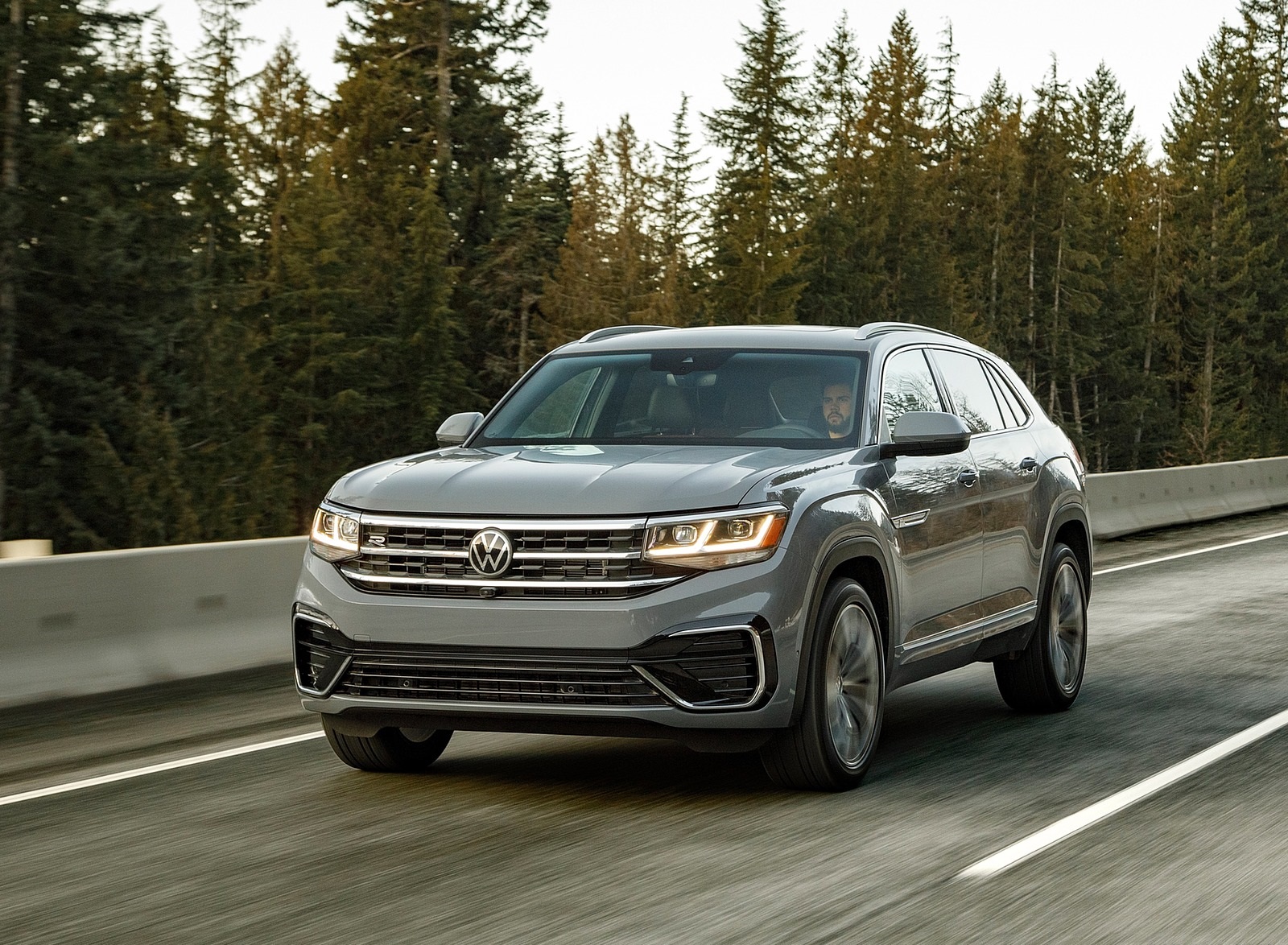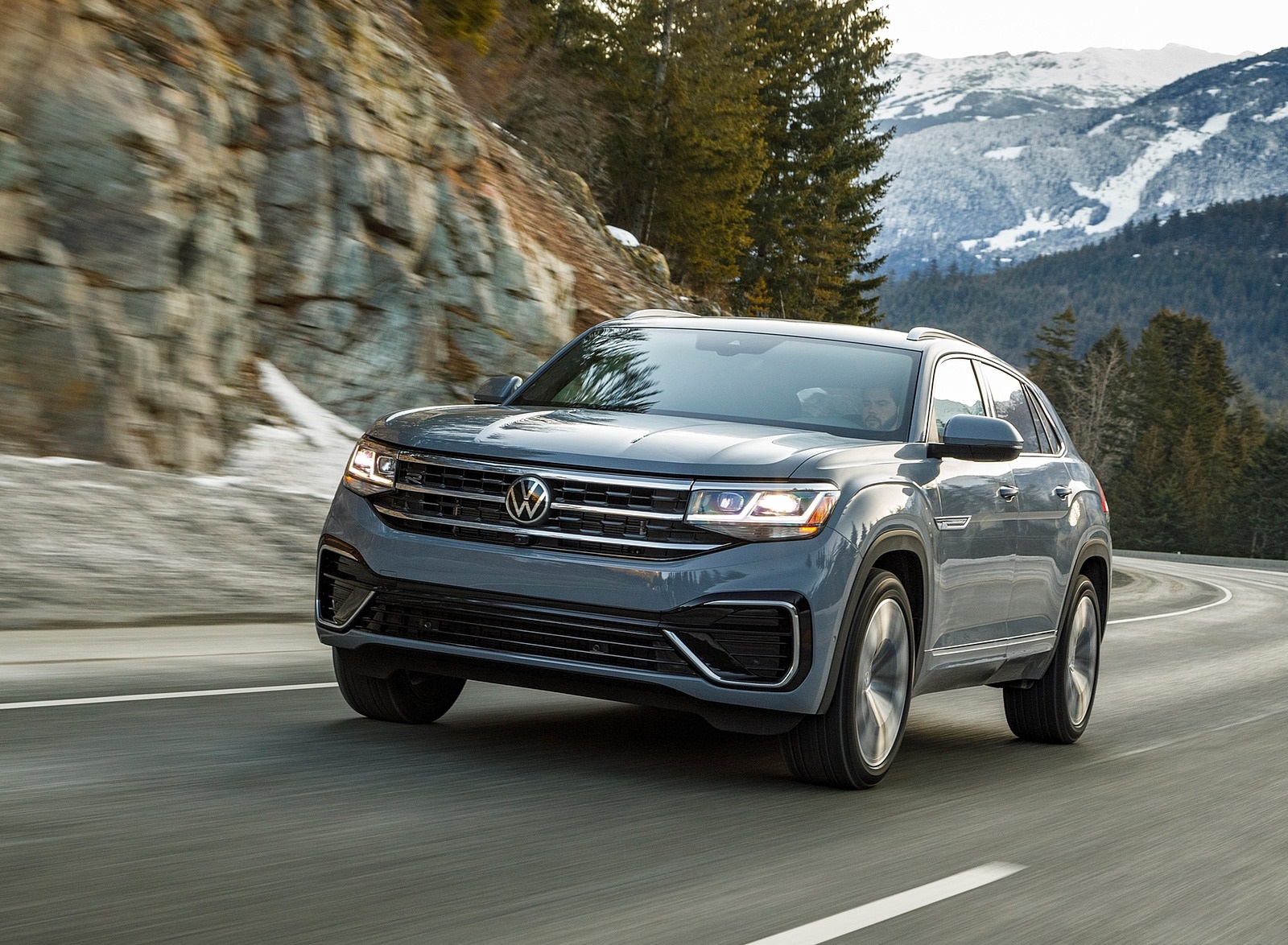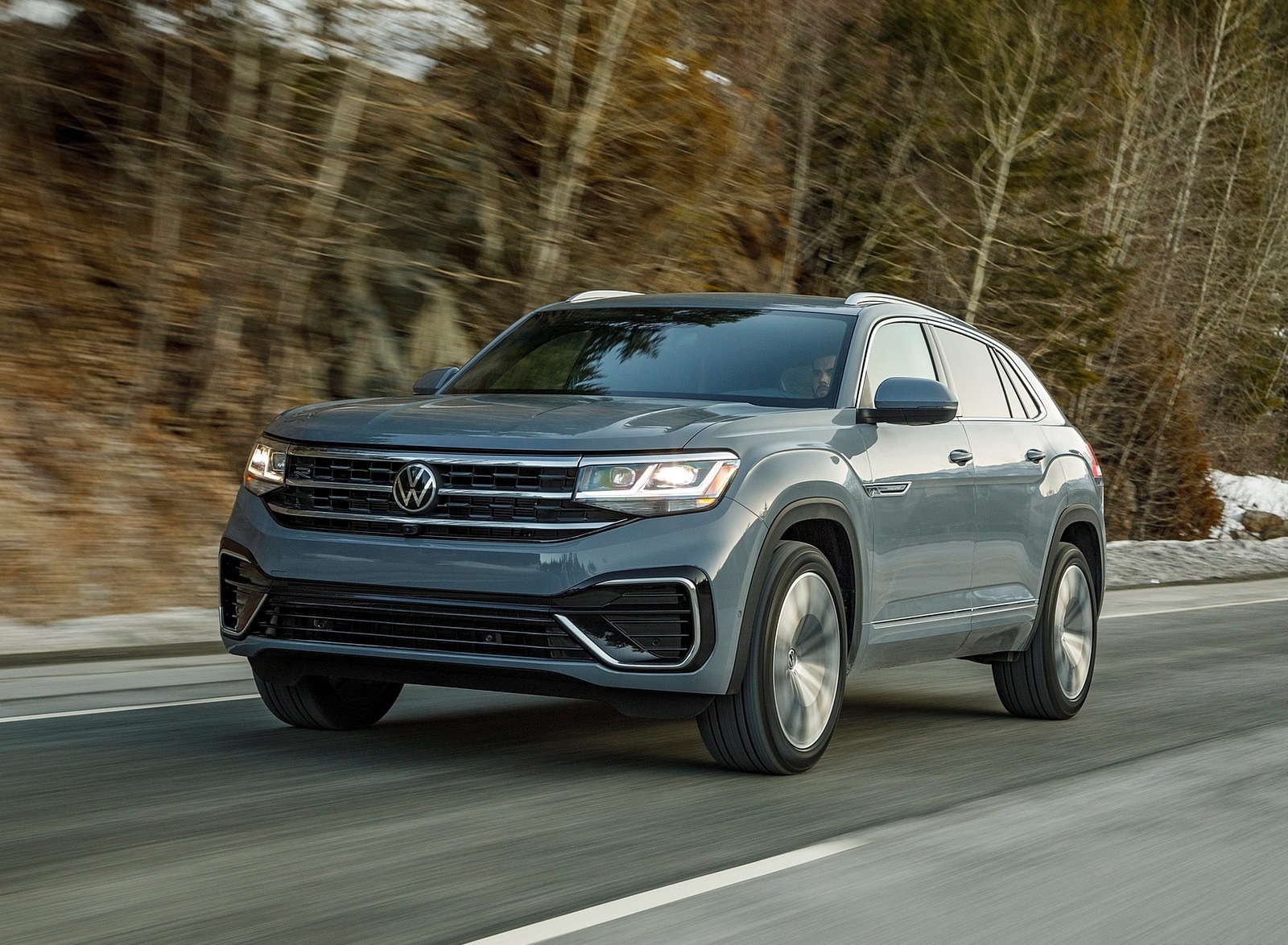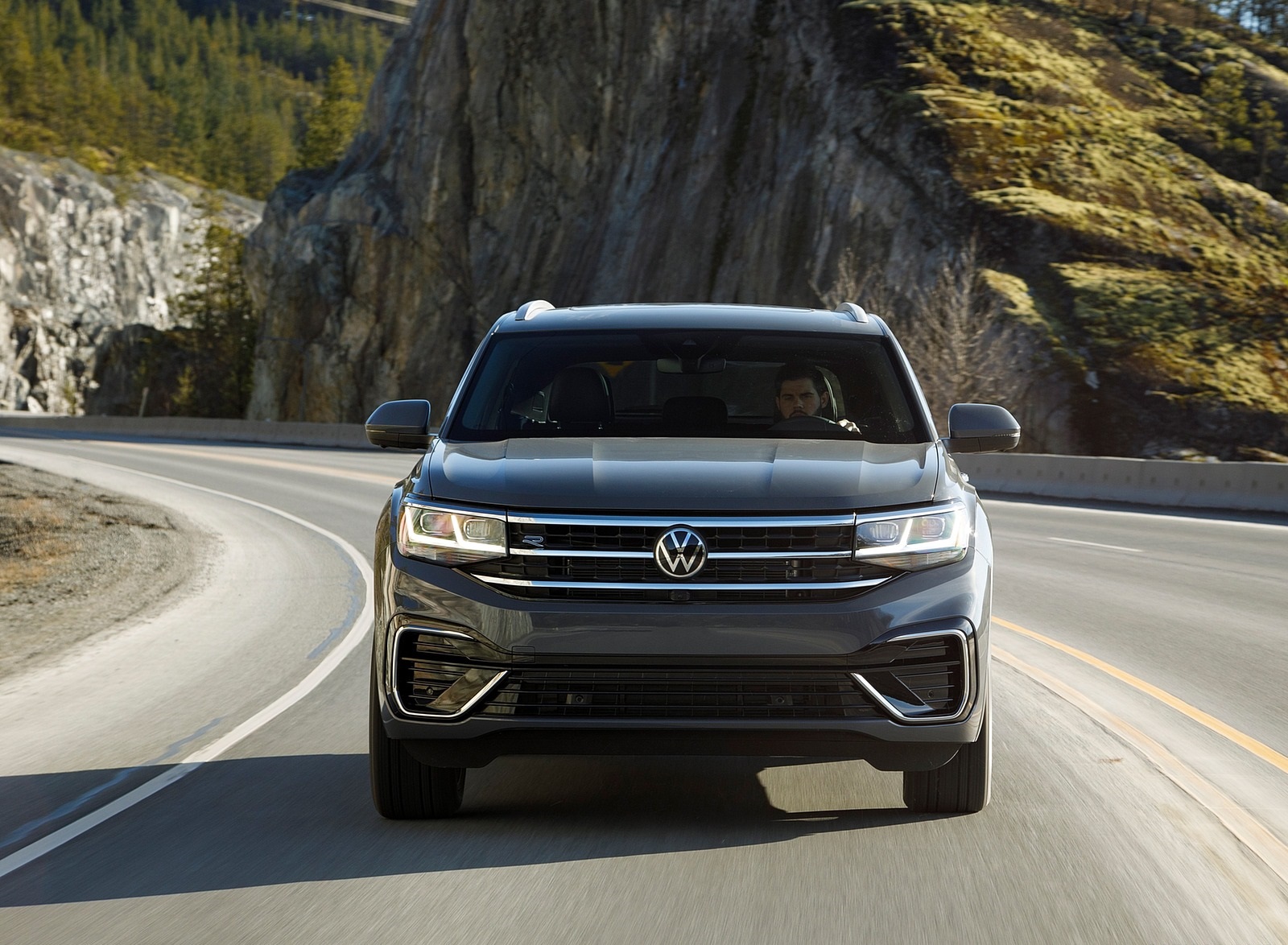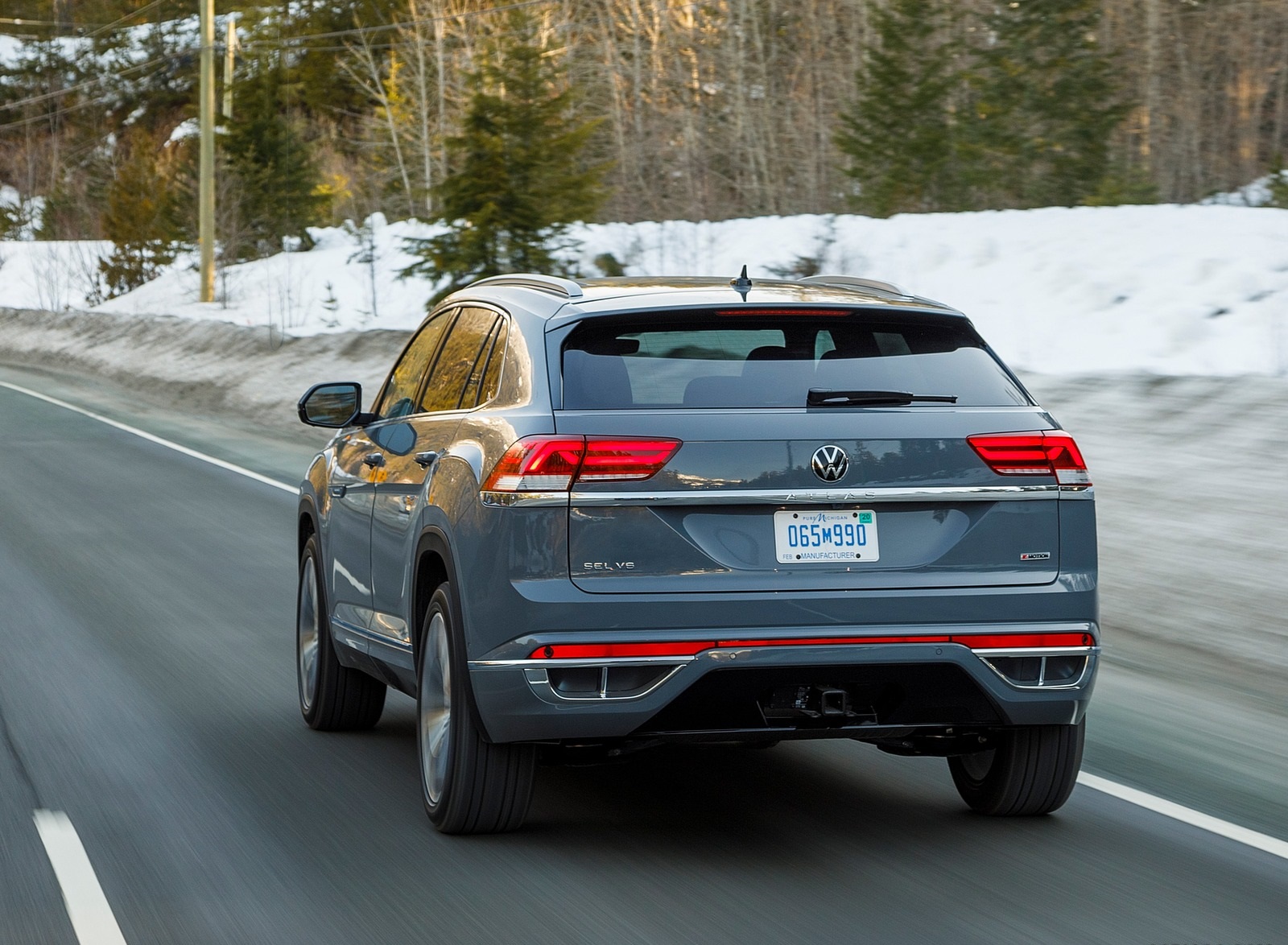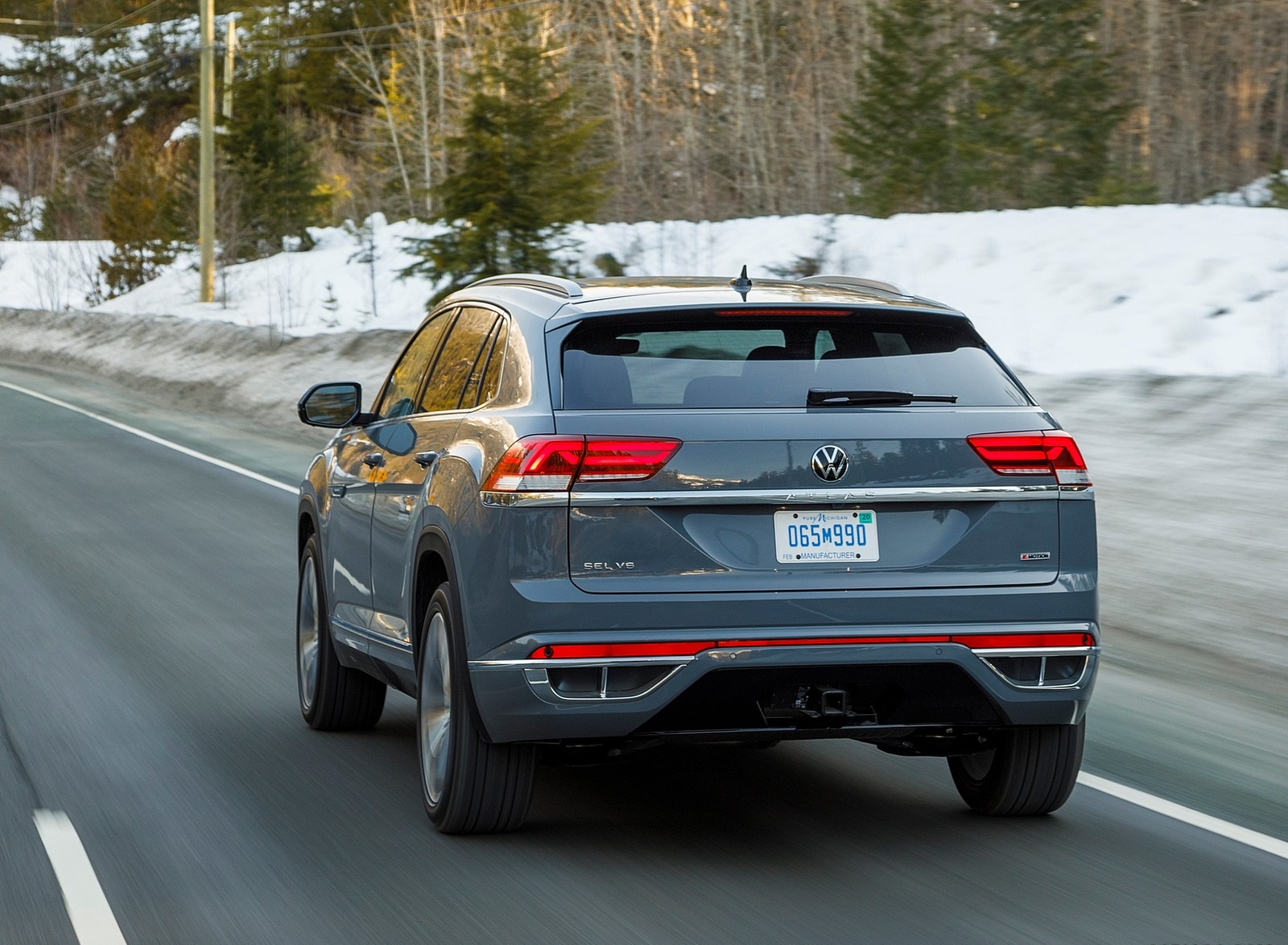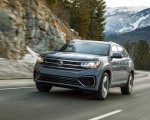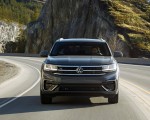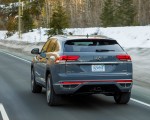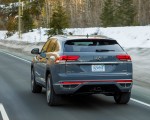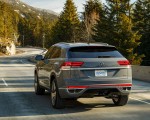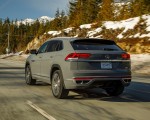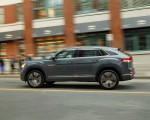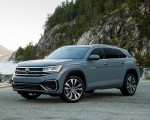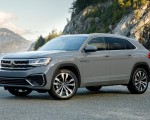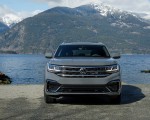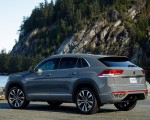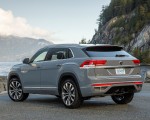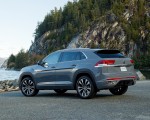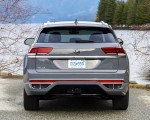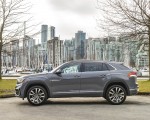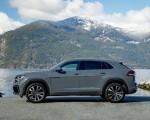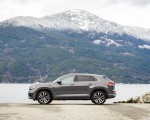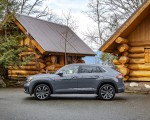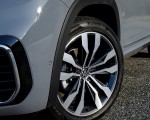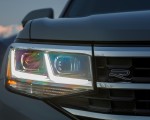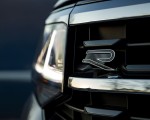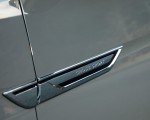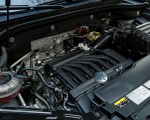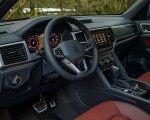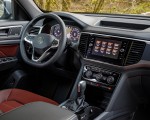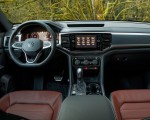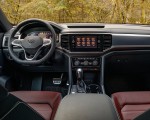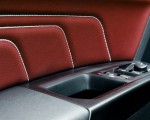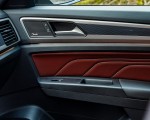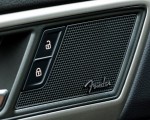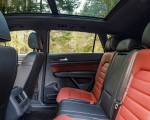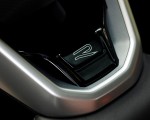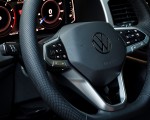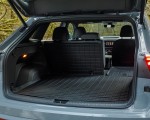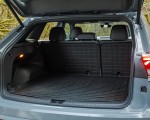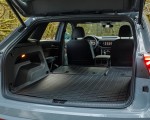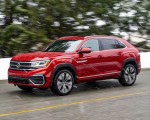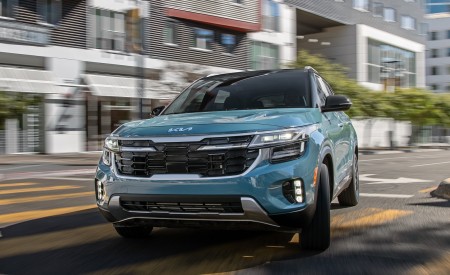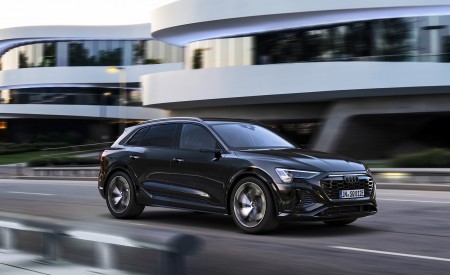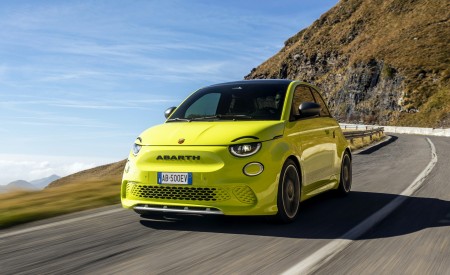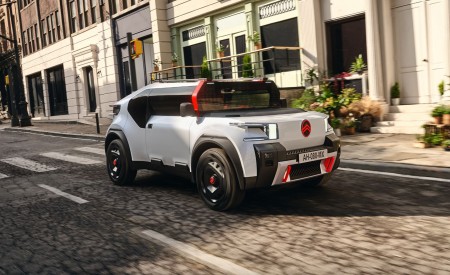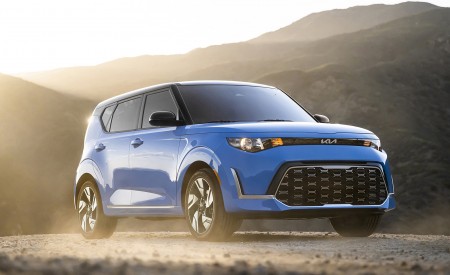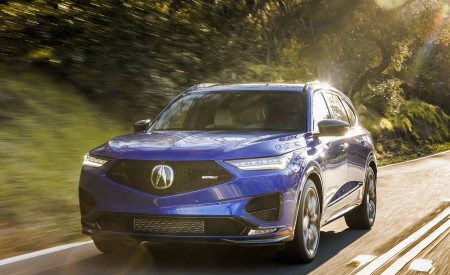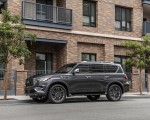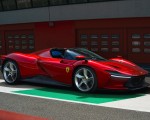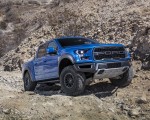2020 Volkswagen Atlas Cross Sport SEL
- MSRP starts at $30,545.
- Standard features include: 18-inch aluminum-alloy wheels, full LED lighting, Front Assist, Blind Spot Monitor, Rear Traffic Alert, and next-generation Car-Net® with Wi-Fi capability.
- Available features include: Volkswagen Digital Cockpit, 20- and 21-inch wheels, heated rear seats, leather seating surfaces, Adaptive Front-light System, ACC, Lane Assist, Traffic Jam Assist, Dynamic Road Sign Display, remote start, and Easy Open rear hatch.
The all-new 5-seater Volkswagen Atlas Cross Sport takes the winning formula of the 7-seater Atlas—ample interior space, plus a host of comfort and technology features at an attractive price—and adds bolder design, as well as advanced connectivity and new driver-assistance features. Assembled in Chattanooga, Tennessee, the Atlas Cross Sport combines hallmark Volkswagen driving dynamics and attention to detail, setting it apart from the competition.
“This is the boldest SUV in the Volkswagen stable,” said Scott Keogh, CEO, Volkswagen Group of America. “Pairing high design with the distinctive driving dynamics and value the brand is known for, the Atlas Cross Sport allows you to show up without showing off.”
The Atlas Cross Sport hosts the latest driver assistance technologies offered by Volkswagen. The next-generation Car-Net® telematics system is fitted as standard, with five years of Remote Access services at no additional charge, and in-car Wi-Fi capability is offered across the lineup when you subscribe to a data plan. Additionally, Traffic Jam Assist and Dynamic Road Sign Display are available for the first time on a U.S. Volkswagen model.
Two powerful engines are offered, the 235 horsepower 2.0-liter TSI® inline-four cylinder (achieved with premium fuel), and a 276 horsepower 3.6-liter VR6®. Every Atlas Cross Sport features an advanced eight-speed automatic transmission and can be optioned with Volkswagen 4Motion® all-wheel drive.
As the newest member of the Volkswagen SUV lineup, the midsize Atlas Cross Sport offers flexible passenger and cargo volume, as well as everyday usability and utility. The Atlas Cross Sport is available in eight trim levels—S, SE, SE w/ Technology, SE w/ Technology R-Line, SEL, SEL R-Line, SEL Premium and SEL Premium R-Line.
Exterior
Engineered from Volkswagen’s award-winning Modular Transverse Matrix (MQB) architecture, the 2020 Atlas Cross Sport builds on the latest Volkswagen design DNA to create a bold new look in the 5-seater SUV segment. The Atlas Cross Sport has a modern design that starts with the classic proportions and clean lines of the Atlas 7-seater and sharpens the angles, trimming visual mass to create a more striking silhouette.
Featuring a lower roofline than Atlas and a dramatically angled rear hatch, the Atlas Cross Sport sits 195.5 inches long, 78.4 inches wide, and 67.8 inches high, giving it an athletic stance slightly shorter in length (5.2 inches), and height (2.2 inches lower) than the 2021 Atlas. Despite its size, the Atlas Cross Sport still offers a low coefficient of drag of 0.34.
Atlas Cross Sport wears an upscale three-bar chrome grille with a new light signature as well as an aggressively styled front bumper. All Atlas Cross Sport models feature full LED exterior lighting, including low beams, high beams, turn signal indicators, Daytime Running Lights (DRLs), side marker lights, and taillights. SEL and SEL Premium models add standard 900-lumen LED headlights with Volkswagen’s Adaptive Front-lighting System (AFS). Automatic headlamps and rain-sensing windshield wipers are standard across the lineup.
Overhead, silver roof rails are standard, and a large panoramic sunroof measuring about 4.5 feet by 3 feet, with a two-part glass opening system and powered sunshade, is available on SE w/ Technology models and standard on SEL and SEL Premium models.
At the back, the Atlas Cross Sport features the same chromed “Atlas” name strip as the 7-seater, but adds a more sculpted rear bumper. A power tailgate is standard on the Atlas Cross Sport SE, while the SE w/ Technology and higher trims add the Easy Open feature. Easy Open works in conjunction with KESSY® keyless access to enable opening of the tailgate with just a kick of the foot below the rear bumper when the key is in range.
S and SE trims feature standard 18-inch aluminum-alloy wheels wrapped in 245/60 all-season tires, while SE w/ Technology and above models boast 20-inch aluminum-alloy wheels and 255/50 all-season tires. SEL R-Line and SEL Premium R-Line trims receive 21-inch wheels and 265/45 all-season tires. All Atlas Cross Sport models feature 8.0 inches of ground clearance and departure angles of 20.4 and 22.4 degrees (front/rear).
R-Line® trims add R-Line badging; unique front and rear bumpers that incorporate stylish air intakes at the front and a diffusor in glossy black paint at the rear; and side skirts, emphasizing the Atlas Cross Sport’s premium profile.
Interior
The interior design of the Atlas Cross Sport is classic Volkswagen—clean and functional, with a premium feel. Driver controls are positioned for optimal ergonomics and usability, and simple, driver-centric displays enhance involvement behind the wheel. The seat position, shifter height, and the spacing between the pedals are all designed for maximum driver comfort. With available two-tone inserts and stitching accents on the door panels as well as a redesigned steering wheel, the Atlas Cross Sport offers a high-end environment that belies its attainable starting price. Ambient lighting, standard on the Atlas Cross Sport SEL Premium, further highlights this upscale character.
Despite its shorter stance and raked rear-end, the Atlas Cross Sport boasts generous interior space for five adults and cargo. Headroom is 39.4/37.8 inches (first/second rows), legroom is 41.6/40.4 inches, respectively, and the Atlas Cross Sport offers a cavernous 112 cu-ft of total passenger volume. Standard rear bench seating offers a 60/40 split, with a 14-degree backrest recline function.
The base Atlas Cross Sport S is equipped with cloth seating surfaces in a quilt-like design. The Atlas Cross Sport SE trims and above come with leatherette seating surfaces, a 10-way power adjustable driver’s seat and a second-row middle armrest with integrated cup holders. SEL models add a three-profile driver’s-seat memory function and an eight-way power passenger seat. SEL Premium models feature standard leather seating surfaces and heated outboard seats for the second row.
An array of available inputs (12V, USB, auxiliary), cup holders, bottle holders, storage nets, and cargo containers provide convenience for all passengers. Atlas Cross Sport has a maximum cargo volume of 77.8 cu-ft behind the front-row seats when the rear seats are folded down, and 40.3 cu-ft when all seats are up.
Dual-zone Climatronic® climate control is standard on Atlas Cross Sport SE and above, along with KESSY keyless access on all five doors, and push-button start. SE and higher trims also include a leather-wrapped multifunction steering wheel, which is heated on SEL models and higher trims. R-Line trims include an R-Line logo on the MIB II start screen as well as an R-Line steering wheel clip and stainless steel pedal caps.
The advanced Volkswagen Digital Cockpit system, standard on SEL trims and above, presents drivers with a fully-digital instrument cluster. Using a 10- inch TFT display, the Volkswagen Digital Cockpit offers a customizable presentation of important vehicle information.
Every Atlas Cross Sport model offers the ability to customize up to four driver settings. Dependent on trim, customizable features include: driver seat memory, mirror settings, driver assistance system preferences, temperature, Volkswagen Digital Cockpit arrangement, and navigation view.
There are two speaker configurations for Atlas Cross Sport—most models include six speakers, while SEL Premium trims feature the Fender® Premium Audio System with 12 speakers.
Fender Premium Audio. The Atlas Cross Sport SEL Premium trim offers the advanced Fender Premium Audio System, which was meticulously engineered to create the emotion of a live performance for all passengers.
The system was developed through collaboration between Fender, the legendary music amplification experts, and Panasonic®. A powerful, 480-watt, 12-channel amplifier delivers arena-sized sound to the spacious Atlas Cross Sport cabin. There are 12 speakers in total, including an innovative center channel speaker, woofer speakers in each door, first- and second-row tweeters, and two wide-frequency speakers and a subwoofer in the rear.
MIB II Infotainment. All 2020 Atlas Cross Sport models feature Volkswagen’s innovative MIB II touchscreen infotainment system. The display utilizes a capacitive-touch sensor (as in smartphone and tablet technology) rather than the more common resistive touchscreens that require pressure, enabling gesture controls like swiping and pinch-zooming.
The Atlas Cross Sport S is equipped with the Composition Color unit, which features a 6.5-inch capacitive touchscreen display. The infotainment system also offers SD card and USB-C (two ports) multimedia interfaces, as well as a rearview camera and standard Bluetooth® technology for compatible devices. App-Connect smartphone integration for compatible devices is standard, and offers users the ability to run select smartphone apps directly on the vehicle’s display through services such as Apple CarPlay®, Android Auto™ and MirrorLink®.
All other Atlas Cross Sport models are equipped with a glass-covered 8.0-inch capacitive touchscreen display and wireless charging for phones. SE and SE w/ Technology models features the Composition Media unit, while SEL and SEL Premium models have the Discover Media system with navigation.
Both units offer four USB-A ports, a JPEG viewer, SiriusXM® radio for a three-month trial period, and HD Radio. Both units also have the ability to send and receive SMS text messages via Bluetooth with compatible phones and can pair two phones simultaneously. The Discover Media unit offers 2.5D navigation, featuring one-shot voice destination entry, typed destination entry with search and auto-complete, and predicts possible destinations based on frequently used routes.
Volkswagen Car-Net
Since its debut for the 2014 model year, Volkswagen Car-Net has allowed Volkswagen owners to get connected to their vehicles. For model year 2020, Car-Net moves into the next generation of integration, with an updated mobile app, a long list of no-charge services for five years, and new subscription options. Car-Net Services will be offered in four areas: Remote Access, Safe & Secure, Hotspot, and Guide & Inform.
Car-Net Remote Access gives owners the ability to interact with their vehicle from miles away via the mobile app. It is offered at no additional charge for five years from the date of vehicle purchase. Features include remote start and stop (if vehicle is equipped), remote door lock and unlock, remote honk and flash of lights, last parked location, and remote vehicle status display, which provides information on fuel level, mileage, and door and window status.
Available later this year, VW Car-Net app for smartwatch (supports select Apple Watch® and Android™ Wear operating systems) will allow VW customers to control a host of functions, available through the iPhone® and Android™ apps, directly from their wrist. Smartwatch wearers can keep tabs on their vehicle from afar, remotely locking and unlocking doors, remotely starting their vehicle (if vehicle is equipped), and viewing the status of doors, windows and sunroof (open or closed). Users can also locate a parked vehicle and receive alerts with a compatible smartwatch.
Volkswagen owners with factory-installed navigation can send destinations or points of interest directly to their car from the app, helping to save time. Coming later this year, owners will also be able to connect their VW Car-Net account to compatible smart home devices to send voice commands to their vehicle to check the fuel level or remote start the engine.
Powered by Parkopedia, the Parking Information feature can help make owners’ lives easier by locating off-street parking information. Through the Navigate tab on the app, users can click the “P” icon to show available parking locations, either in the immediate vicinity or near a Point of Interest. Clicking on a specific location will display the address, hours of operation and pricing. Users can also send the location to their car’s navigation system, if so equipped, by clicking the “Send to My VW” button.
Vehicle Health Reports can provide owners easy access to diagnostic information. Reports generate automatically each month after enrollment and are sent directly to the email address in the owner’s profile; owners can also request updated reports anytime through the mobile app. When it’s time for scheduled service, Car-Net can not only notify the customer, but also provide a simple way to schedule a dealer visit.
Family Guardian services and Roadside Call Assist can provide added peace-of-mind no matter who is driving. Speed alert notifies the owner when the pre-determined maximum speed limit is exceeded. Boundary alert lets the owner know when the vehicle has traveled outside of a pre-set virtual boundary. Curfew Alert notifies the owner if the vehicle is driven outside specified timeframe, while Valet Alert alerts if the vehicle is driven more than 0.2 miles from the valet drop-off location. The Car-Net app allows users to control who receives notifications by designating primary and secondary users, with varying levels of control and functionality for each. Notifications can come in the form of text messages, emails, or push notifications from the mobile app itself. If the vehicle is disabled, Roadside Call Assist is available at the touch of the wrench button.
The DriveView™ program is new for 2020. By enrolling in this program, Car-Net users may be eligible for discounted rates from some of the top automotive insurance companies in the country. This program can also help Car-Net users monitor their driving by tracking activities like night driving, hard braking and idle time. These factors all contribute to an overall driving score, which is visible within the mobile app.
Car-Net Safe & Secure is a paid subscription service that includes Information Assistance, Emergency Assistance, Automatic Crash Notification, Anti-Theft Alert, and Stolen Vehicle Location Assistance. The subscription is $99 per year before taxes and fees, and automatically renews annually at the end of the subscription term, unless cancelled. Information Assistance—accessed through the i-call button within the vehicle—allows the driver to speak to a Car-Net agent for support needs, such as points of interest and account services.
Emergency Assistance can be accessed through the SOS button in the vehicle, and, if a cellular connection can be established, puts the driver in contact with the Car-Net service center, who can direct emergency responders to the vehicle’s location and notify the user’s Emergency Contact. Provided a cellular connection can be established, Automatic Crash Notification can help automatically notify an operator who can quickly contact first responders in the event of a collision. Anti-Theft Alert sends a push notification to the user if the vehicle’s anti-theft alarm is triggered, and Stolen Vehicle Location Assistance uses Car-Net to assist law enforcement with locating the vehicle in the event that it is stolen.
Car-Net Hotspot allows passengers to access the internet with up to four connected devices simultaneously, including tablets, smartphones, laptops, gaming devices, and more— at 4G LTE-enabled speed. Existing Verizon Wireless customers with an unlimited mobile data plan can simply add their Volkswagen vehicle as a new line item to their existing plan, and non-Verizon customers can set up a prepaid plan for $20/month before taxes and fees.
Car-Net Guide & Inform offers an enhanced navigation and infotainment experience for VW owners with a factory-installed navigation system. Drivers can access traffic reports, fuel prices, sports scores, movie times, and weather data as part of the three-month SiriusXM Travel Link trial. Car-Net enrollment and subscription is not required.
Powertrains
Atlas Cross Sport is offered with a choice of two engines—a 2.0-liter turbocharged four-cylinder or an available 3.6-liter VR6® engine. Both units feature start/stop technology. Remote start is standard on SE w/ Technology trims and above, and can also be added as an accessory on S and SE models.
The 2.0-liter four-cylinder gasoline unit is a member of the EA888 engine family, using a turbocharger and direct fuel injection to balance efficiency and power. Output is rated at 235 horsepower at 4,500 rpm and 258 lb-ft of torque from 1,600 rpm (achieved with premium fuel).
Augmenting the EA888’s 16-valve, dual-overhead-camshaft layout is Volkswagen’s latest variable cam phasing system, which controls both intake and exhaust valves, as well as a variable lift system for the valves themselves. The single-scroll turbocharger feeds intercooled air through the aluminum-alloy crossflow cylinder head. The cast-iron engine block uses a wall thickness of just 0.12 inches to help reduce its weight to 72 pounds, while a lightweight polymer oil pan and aluminum-alloy screws and fasteners also reduce mass. Another change that helps the engine to shed pounds is a reduction from eight to four crankshaft counterweights. Internal friction is reduced due to measures such as roller bearings for the engine’s balancer shafts and a reduction in the size of the engine’s main bearings.
The engine is also compact. The exhaust headers have been integrated directly into the cylinder head, not only optimizing the system coolant operation (aiding rapid warm-up, which is designed to help improve efficiency), but also allowing greater thermal management of the exhaust stream.
Atlas Cross Sport SE w/Technology and higher trims are available with a 3.6-liter VR6 engine. This powerful direct-injection engine delivers 276 horsepower at 6,200 rpm and 266 lb-ft of torque at 2,750 rpm. The engine utilizes a crossflow aluminum-alloy cylinder head design, twin overhead camshafts, four valves per cylinder, and variable valve timing.
With either engine, power is sent through an eight-speed automatic transmission which is designed to help maximize efficiency. This transmission then sends the power to either the front wheels, or—if equipped with 4Motion with Active Control all-wheel drive—all four wheels as needed.
Atlas Cross Sport models equipped with the VR6 engine and a factory-installed trailer hitch (SEL and SEL Premium) offer a towing capacity of 5,000 lbs., while all other models require dealer- or port-installed trailer hitch, and then allow for a maximum towing capacity of 2,000 lbs.
All Atlas Cross Sport models are outfitted with an 18.6-gallon fuel tank. EPA-estimated fuel economy for the 2020 Atlas Cross Sport when equipped with the 2.0-liter 4-cylinder is 21/24/22 mpg (city/hwy/combined), and 18/23/20 when equipped with the 4Motion all-wheel-drive system. EPA-estimated fuel economy for the V6 front-wheel-drive models is 17/23/19 mpg (city/hwy/combined); models with 4Motion all-wheel drive are rated at 16/22/19 mpg.
4Motion All-wheel-drive System
Atlas Cross Sport can be equipped with the available 4Motion with Active Control all-wheel-drive system. The latest-generation 4Motion system is designed to activate before wheelspin occurs, helping eliminate traction losses. The system achieves this by using an advanced control function based on specific driving conditions. When operating under a relatively low load or when coasting, the front wheels are driven and the rear wheels are decoupled, a feature designed to help to save fuel. However, the rear wheels can be engaged in fractions of a second whenever necessary via the center differential, which is activated by an electro-hydraulic oil pump.
A control unit continually calculates the ideal drive torque for the rear wheels and controls how much the multi-plate clutch should be closed by activating the oil pump. The oil pressure increases the contact pressure at the clutch plates in proportion to the torque desired at the rear axle. So, the amount of pressure applied to the clutch plates can be used to continuously vary the amount of torque going between the front and rear wheels, up to a maximum of 50 percent at the rear axle.
In addition to the center differential that acts longitudinally, electronic differential locks that are a function of the Electronic Stability Control (ESC) system act laterally. The system can briefly brake a wheel that is slipping, enabling uninterrupted and stable transfer of drive power to the wheel on the opposite side.
Active Control. All Atlas Cross Sport models with 4Motion all-wheel drive feature Active Control, which allows the driver to select specific vehicle profiles based on driving conditions. It has four settings: Onroad, Snow, Offroad, and Custom Offroad. Within the “Onroad” setting, additional options are offered: Normal, Sport, Comfort, and Individual. These alter operating parameters for drive systems like the engine, transmission, steering, and Adaptive Cruise Control (ACC), as well as traction-assistance systems like Hill Descent Assist and Hill Start Assist. The singular user interface is highly intuitive, comprising both a rotary knob and a push-button. Turning the knob engages the various drive modes, while pushing the button triggers a pop-up menu on the screen of the infotainment system, allowing the driver to fine tune the Onroad mode.
Onroad mode is the default setting. Here, the Atlas Cross Sport automatically varies the drive distribution between the two axles, accounting for road conditions. A press of the button triggers the driving profile selection screen to pop up on the infotainment screen, offering the driver a choice of “Normal”, “Sport”, “Eco”, and “Individual” drive modes. Within each, the tuning parameters for the engine control, gearbox, steering and optional ACC are varied.
In Snow mode, the controls are adjusted to help negate unintentional and excessive wheelspin, and the transmission upshifts earlier to help optimize traction. Communicating with the accelerator pedal and individual wheel speed sensors, the Traction Control System (TCS) helps reduce engine power the moment it detects slippage. The sensitivity of the system is more relaxed in straight-line situations to allow adequate power transfer, while the limits are tightened in cornering, where traction is of paramount importance. Last but not least, ACC is switched to the more defensive “Eco” driving profile when in Snow mode.
Offroad mode offers similar throttle and transmission characteristics to Snow mode, adding manual control of transmission shifting via Tiptronic® (only the throttle kickdown switch will force a downshift). The Start/Stop system is switched off in this mode, and ACC operates normally. The ESC system is relaxed to help avoid false positives often encountered off-road, and Hill Descent Control is automatically activated on gradients of more than 10 percent. It functions at speeds between approximately 1 mph and 19 mph, and is adjustable via brakes or throttle.
With unique Offroad ABS programming, the wheels can lock up briefly before the system reduces the brake pressure. This allows time for a small wedge of material from the ground (such as gravel or sand) to build up in front of the wheel, thus helping increase the braking effect. This means that the car still remains steerable while its stopping distance can be substantially reduced.
Finally, Custom Offroad mode allows the driver to alter the steering, engine and gearbox behavior as well as Hill Descent Assist and Hill Start Assist.
Chassis
Atlas Cross Sport is built on the same MQB chassis architecture as most other vehicles in the Volkswagen lineup. The unitary construction chassis has two solid-mounted subframes with bolt-on front fenders, and utilizes advanced technologies such as the laser clamp welder, which produces “wobble seam” welds in a wave pattern to help maximize strength in a limited space.
The stamped steel body and chassis boasts a large percentage of high-strength, hot- formed steel. This technology, along with the use of newly developed ultra-high- strength steels, allows much of the chassis and body to be constructed from thinner, and lighter parts without any loss in strength.
Thanks to the extensive use of modern construction techniques and high-strength and ultra-high strength steels, the Atlas chassis manages to remain lightweight despite its upscale features and enhanced structure. Throughout the car, incredible attention to detail has optimized components—such as the seats, air conditioning unit, and even the electrical architecture—to help reduce weight.
Atlas features independent suspension for all four wheels. In the front, Atlas features a strut layout with coil springs and telescopic dampers, and at back, a multilink arrangement with coil springs and telescopic dampers.
The braking system on the Atlas Cross Sport is comprised of 13.2-inch vented front discs and solid 12.2-inch rear discs with standard three-channel ABS with electronic brake pressure distribution. The rack-and-pinion steering features electric power assist and speed- sensitive variable steering assist. This system offers a 13.6:1 steering ratio that allows for 2.76 steering wheel turns from lock to lock and a vehicle turning circle of 40.51 feet.
Safety
To help protect occupants, the Atlas Cross Sport provides a combination of both passive and active safety systems. It features six airbags as standard (front and side airbags for front passengers and side curtain airbags for outboard seating positions), along with a number of electronic safety systems, such as an Anti-lock Braking System (ABS) and Electronic Stability Control (ESC).
A standard feature on the 2020 Atlas Cross Sport is Volkswagen’s Automatic Post-Collision Braking System. This builds on the premise that a collision is rarely a single, instantaneous action, but rather a series of events that follow the initial impact—the most significant of which can cause additional collisions. The Automatic Post-Collision Braking System helps address this, in certain crash scenarios, by applying the brakes when a primary collision is detected by the airbag sensors, thus potentially reducing residual kinetic energy and, in turn, the chance of additional damage.
The Atlas Cross Sport also includes Volkswagen’s Intelligent Crash Response System that shuts off the fuel pump, unlocks the doors, and switches on the hazard lights if the car is involved in certain types of collisions.
All Atlas Cross Sport models feature a standard rearview camera; SE models and above feature dynamic guidelines.
Driver-Assistance Technology
To meet the demands of American drivers, the 2020 Atlas Cross Sport offers a comprehensive suite of driver-assistance technology. Available features include: Forward Collision Warning and Autonomous Emergency Braking with Pedestrian Monitoring (Front Assist); Blind Spot Monitor; Rear Traffic Alert; Adaptive Cruise Control (ACC); Lane Keeping System (Lane Assist); Traffic Jam Assist; Park Distance Control; Parking Steering Assistant (Park Assist); Dynamic Road Sign Display; High Beam Control (Light Assist); and Overhead View Camera (Area View).
Front Assist, standard on all trims, is intended to warn drivers of potential frontal collisions (Forward Collision Warning) with vehicles and pedestrians, and in some cases provide automatic braking assistance (Autonomous Emergency Braking).
Within physical system limits, Forward Collision Warning warns the driver of potential critical front-end collision situations, both acoustically and visually by a warning symbol in the instrument cluster if the car is traveling above 18 mph. Furthermore, an automatic jolt of the brakes can warn the driver of the danger. If the driver fails to brake, or if the car is traveling below 18 mph, Autonomous Emergency Braking is activated to help slow the vehicle. If the brake pedal is applied but the driver brakes too lightly, the brake pressure is increased by the system (Braking Support).
Blind Spot Monitor is standard on all Atlas Cross Sport models. Blind Spot Monitor uses two radar sensors at the rear of the vehicle to scan the approaching traffic and is intended to warn drivers of the presence of other vehicles in adjacent lanes. If the driver uses the turn signal to indicate a lane change while a vehicle is detected in a blind spot, the system utilizes a flashing LED symbol in the outer area of the side mirrors. Even if the driver does not use a turn signal, the LED symbol in the mirror will illuminate if a vehicle is detected in the blind spot. The system is designed to help alert drivers in specific situations; stationary objects or oncoming vehicles do not trigger warnings, nor do vehicles more than one lane away from the vehicle.
If combined with Lane Assist (SEL models and above, see below) the system not only warns the driver with the flashing LED symbol if a vehicle is detected in the blind spot, but within system limits, it can also countersteer to help keep the car in the lane even if the turn signal is on. If the driver still tries to steer out of the lane, the system will warn with an additional vibration of the steering wheel.
The Rear Traffic Alert system, standard on all models is intended to detect vehicles approaching from the side that may be difficult for the driver to see while reversing. The system offers a 180-degree view of the back of the car with a range of 65 feet, and will present a visual and an acoustic warning, if a potential collision with a crossing vehicle is detected. If the driver does not react, the system can apply the brakes to help mitigate and, in the best case, can prevent a collision. The system is activated by putting the car in reverse.
Adaptive Cruise Control (ACC), standard on SE w/ Technology models and above, uses a forward facing radar to maintain a set speed while helping maintain a set distance to the vehicle in front. The driver sets the speed and the desired spacing via buttons on the multifunction steering wheel and can further use those buttons to adjust and cancel the ACC function. Additionally, the accelerator can be used to override the ACC function, and pressing the brakes always cancels the ACC function. All ACC-related system messages appear in the central multifunction display.
When the roadway ahead of the vehicle is clear, the system maintains the set speed. Atlas Cross Sport models fitted with ACC can match a vehicle in front and come to a stop if the vehicle in front does. If the car in front moves within three seconds, ACC will automatically resume the set speed. If the car stands longer than three seconds, the driver can resume ACC control by pressing the accelerator pedal or the “resume” button on the steering wheel.
Lane Keeping System (Lane Assist) is standard on SEL models and above. When driving above 40 mph, if the system’s camera recognizes lane boundaries and, using a special algorithm, calculates that the vehicle is unintentionally straying from its lane without using a turn signal, Lane Assist actively countersteers to help keep the vehicle in the lane. If the driver takes his or her hands off the wheel for a defined period of time, the system provides an audible warning and a visual signal in the instrument cluster, asking the driver to take over.
The system will not engage if it cannot properly detect lane boundaries. If the turn signal has been set before crossing a lane marking, the Lane Assist system will not engage or give a warning. The driver can override the system at any time by applying minimal force to the steering wheel.
Available for the first time on a U.S. Volkswagen model, Traffic Jam Assist makes driving in stop-and-go conditions and traffic jams much less stressful. Using the Lane Assist system and the ACC system, the Atlas Cross Sport can steer, accelerate and brake entirely automatically up to speeds of 37 mph. The system is standard on the Atlas Cross Sport SEL and SEL Premium trims.
Park Distance Control, equipped on Atlas Cross Sport SE w/ Technology models and above, uses ultrasonic sensors located in the front and rear bumpers to monitor a range of up to approximately five feet in front or behind the vehicle. The system may activate below 9 mph and helps provide guidance when parking or in tight spaces. The system has audible and visual warnings when the car starts to approach parked cars or static objects of sufficient size from the front or rear.
Maneuver Braking, a part of the Park Distance Control system, is intended to mitigate or help prevent collisions with recognized static obstacles to the front and rear while the vehicle is maneuvered. The system is active between 1-6 mph. If the system detects a stationary object, it can apply the brakes automatically to help prevent or mitigate a collision. The system can be deactivated at any time using the touch display or permanently in the setup menu.
Parking Steering Assistant (Park Assist) is standard on Atlas Cross Sport SEL Premium models. This system can automatically steer the car into parallel and perpendicular parking spaces (the latter both forward and in reverse). While driving below 25 mph, pressing the Park Assist button in the center console will activate the system to scan the left and right sides of the vehicle for parking spots. By using the turn signal indicator, the driver can indicate which side of the road they would like to park. When the system detects a space, “Parking Space Found” will appear in the multifunction display. The driver only need activate the accelerator pedal and brake once a gear is selected, as Park Assist can automatically help steer the vehicle into the parking space. The driver can override or deactivate the steering assistance at any time by turning the steering wheel or pressing the button.
Dynamic Road Sign Display, standard on the Atlas Cross Sport SEL and SEL Premium models, uses a forward-facing camera to detect and read road signs. After verifying the information with signage data stored in the onboard navigation, the system alerts the driver on the Atlas Cross Sport Discover Media screen in the center console, and on the Digital Cockpit instrument display.
High Beam Control (Light Assist), standard on Atlas Cross Sport SEL models and above, helps provide drivers with better visibility by automatically switching on the headlamp high beams above 37 mph on dark or poorly lit roads, if there is no oncoming traffic detected. Below 18 mph, the high beams automatically switch off. Finally, the Overhead View Camera (Area View) offered on Atlas Cross Sport SEL Premium models, uses the car’s four cameras to supplement the driver’s view of what is around the vehicle.
Warranty & Maintenance
Every 2020 Atlas Cross Sport comes with a Bumper-to-Bumper Limited Warranty and Carefree Maintenance Program. The warranty provides coverage for four years or 50,000-miles (whichever occurs first), and can be transferred to a subsequent owner throughout the remainder of its duration. The Carefree Maintenance Program provides scheduled maintenance services for 2 years or 20,000 miles (whichever occurs first) at no additional charge, and can be transferred to a subsequent owner throughout the remainder of its duration.


